My Humans Think They Trained Me… Cute, Right?

Tips & Tricks for Dealing With Great Danes
Woof! Hi there, humans! It’s me, your friendly neighborhood Great Dane, and boy, do I have some things to tell you about living with us giants!
Don’t be surprised when I try to squeeze onto your couch or accidentally knock over your coffee table with my tail. It’s not my fault, everything in your house is built for tiny creatures!
Here’s the thing about us Great Danes – we’re gentle giants with the hearts of golden retrievers and the size of small cars. We love attention SO much. Like, seriously, we need pets and cuddles constantly. If you ignore us for five minutes, we might get worried and follow you around the house like a furry shadow. We’re 150-pound babies who just want to make sure you still love us.
Training is super important for us big guys. Trust me, you don’t want an untrained Great Dane jumping on your grandma! Use treats and praise – we’re total suckers for both. Be patient with us because sometimes our brains take a while to catch up with our giant paws.
Oh, and please take us to the vet regularly! Our big bodies can have big problems, so catching stuff early is essential. Feed us good food too – we need lots of fuel to power these massive frames, but don’t let us eat too fast or we might get sick.
With the right care, we’ll be your goofy, lovable best friends forever!
Understanding the Size and Physical Characteristics of Great Danes
First off, can we talk about these “size misconceptions” you humans have? I heard someone call me an “oversized dog” the other day. Oversized? I prefer “perfectly sized for maximum cuddles and counter surfing.”
Sure, I might be 34 inches tall, but that just means I can reach the good snacks you hide on top of the fridge.
At 34 inches tall, I’m just your snack-fetching superhero with a knack for reaching the hidden goodies!
You know what’s funny? People always compare us to those little dwarf breeds. No offense to my tiny cousins, but while they’re down there being “compact,” I’m up here with the best view in the house.
I can see everything – the mailman three blocks away, that squirrel plotting in the backyard, and yes, the cookies you thought you hid.
My broad chest isn’t just for show – it’s perfect for giving bear hugs that might accidentally knock you over. And these powerful limbs? They’re great for running, jumping, and pretending I’m a lap dog, even though I weigh more than most middle schoolers.
The truth is, we Great Danes are just big softies who happen to think we’re the size of Chihuahuas.
We’re graceful… until we’re not. We’re majestic… except when we’re drooling on your clean shirt. But hey, that’s all part of our charm! Plus, our muscular frame helps us stand out as gentle giants among other breeds.
Nurturing the Gentle Giant: Temperament and Behavior
First things first: we’re called “gentle giants” for a reason. Sure, I might accidentally knock over your coffee table with my tail (sorry about that!), but I’d never hurt a fly on purpose. Well, maybe a fly, but not you! We Great Danes are oversized teddy bears who think we’re lap dogs. Yes, I’ll try to sit on your lap, and no, I don’t care that I weigh 150 pounds.
Here’s the thing about us – we LOVE people. Like, seriously love them. If you leave me alone for five minutes, I’ll act like you’ve been gone for five years when you come back. We’re pretty much professional cuddlers and expert couch warmers. Some people think big dogs are scary, but we’re more likely to lick an intruder to death than bite them.
Now, about that socialization stuff humans always talk about – it’s super important! When we’re puppies (and yes, we’re adorable even though we look like baby giraffes), we need to meet lots of different people and animals. Otherwise, we might get nervous around strangers, and nobody wants a nervous 150-pound dog hiding behind their legs!
Don’t let our goofy personalities fool you, though – we do have protective instincts. If someone sketchy shows up at your door, my deep bark will let them know there’s a giant dog in the house. But honestly, after that impressive announcement, I’ll probably just want belly rubs from the visitor. Remember, our natural protectors often create a protective barrier by positioning themselves between family and perceived dangers.
The secret to living with us? Patience, lots of food, and an understanding that everything in your house now belongs to a Great Dane!
Affectionate Companionship Needs
Hey there, humans! Let me tell you about what us Great Danes need – lots and lots of love and attention!
I know I’m huge and might seem scary when I tower over you, but trust me, I’m just a big softie who wants to be your best buddy. We Great Danes are gentle giants who live for hanging out with our favorite people (that’s you!).
Here’s the thing – I get super attached to my family. Like, attached. I’ll follow you around the house, plop down next to you on the couch (sorry if I take up the whole thing), and give you those puppy dog eyes until you pet me. I can’t help it! I just love being near you.
Sometimes I want to run around and play fetch or tug-of-war. Other times, I just want to chill and maybe rest my giant head on your lap while we watch TV. Fair warning, though – when I say “rest my head,” I mean all 30 pounds of it!
The best part about having me as your dog is that I’ll be the most loyal friend you’ve ever had. Just give me plenty of belly rubs, ear scratches, and quality time together. Remember, early socialization is key to developing my loving and loyal personality!
Trust me, when you show me love, I’ll give you ten times more back. We’ll make an awesome team!
Socialization for Harmony
Woof! Let Me Tell You About Making Friends
Hi there! I’m a Great Dane, and trust me, being this big means I need to learn how to get along with everyone. When my humans helped me meet lots of people and dogs early on, I became the coolest, most chill giant you’ll ever meet!
My secret? Going to dog parks! Sure, I might accidentally step on a Chihuahua or two (sorry, tiny friends!), but these adventures taught me so much:
- I learned not to jump on people (apparently, knocking over your mailman isn’t “friendly”)
- Now I’ve buddies of all sizes, from Great Danes like me to cats who think they’re in charge.
- All that running around keeps my brain busy and my body tired (which means less couch destruction – you’re welcome, humans!)
The best part? When you’re properly socialized like me, every house becomes peaceful. No more barking at the doorbell or hiding under tables during parties. I’m a 150-pound teddy bear who knows when to be gentle and when to play! Plus, I’ve got my humans to thank for systematic early socialization that helped me thrive in a multi-dog environment.
Trust me, a little early socializing goes a long way when you’re big enough to accidentally redecorate the living room just by wagging your tail!
Protective Instincts Explained
My Protective Side – A Great Dane‘s Story
Hey there! Let me tell you about my natural instinct to protect my family. Being a Great Dane means I was born to be a guardian – it’s like having a superhero gene, except I’m way more handsome than any caped crusader!
My protective feelings kick in automatically when it comes to my humans. I’m like a furry security system that never needs batteries. When someone approaches our house, my inner alarm bells start ringing, and I feel this overwhelming urge to let everyone know I’m on duty.
Sometimes I get so excited about protecting that I forget how big I am and accidentally knock over the coffee table while rushing to the window.
The thing is, my humans figured out that my protective nature needs some fine-tuning. They’ve been teaching me the difference between “real threat” and “mailman just doing his job.” Apparently, barking at every leaf that moves isn’t exactly what they’d had in mind when they wanted a watchdog.
Through training and meeting lots of different people, I’ve learned to use my protective instincts wisely. Now I can be the gentle giant my family loves while still keeping them safe. Great Danes thrive on human interaction, and I’ve mastered the art of looking intimidating when necessary but turning into a wiggling goofball when I meet friendly strangers. It’s all about reading the room – and trust me, my room-reading skills are top-notch!
Practical Training and Socialization Techniques
How to Train Me: A Great Dane‘s Guide to Making Humans Happy****
Hey there, humans! It’s me, your friendly neighborhood Great Dane, and I need to talk to you about this whole “training” thing.
First things first: that leash thing you keep putting on me. Look, I get it – you don’t want me dragging you down the street like a sled dog. Start teaching me early how to walk nicely, okay? My legs might be longer than a giraffe’s, but I promise I can learn to match your tiny human steps. Just be patient with me!
Now, about meeting new people and dogs – this is super important! I might look scary because I’m enormous, but inside I’m a gentle giant who just wants to be everyone’s best friend. Please take me to different places so I can learn that the mailman isn’t actually a monster and that small dogs aren’t squeaky toys. The more friends I meet, the less likely I’m to accidentally knock over your neighbor while trying to give them kisses.
Meeting new pals is crucial! I’m a gentle giant who just wants to spread love and joy, so let’s make friends together!
Here’s the secret sauce: treats and praise work like magic on us Great Danes! When I do something good, tell me I’m the best dog ever and maybe toss me a snack. We’re giant puppies who live for your approval. Skip the yelling – it just makes us sad and confused. Remember, positive reinforcement techniques are key to our training success!
Remember, I’m still learning how to control this massive body of mine. With some patience and lots of love, I’ll become the well-behaved gentle giant you always dreamed of.
Plus, when I’m well-trained, other people won’t run away screaming when they see me coming!
Health Considerations and Lifespan Expectations
Health Considerations and Lifespan Expectations
Woof! Let me tell you about staying healthy when you’re as big as me – a Great Dane! Being a gentle giant isn’t always easy, but I’ve learned a few tricks along the way.
First off, us Great Danes have some health stuff our humans need to watch out for. Think of me like a tall person who sometimes bumps their head on doorways – except my version is things like bloat (when my tummy gets twisted up) and hip problems from carrying around all this magnificent size!
My human friends need to spot trouble early. If I’m acting weird, not eating my dinner (which NEVER happens unless something’s wrong), or walking funny, it’s time for a vet visit. I might try to hide it because I’m tough, but my humans know me too well.
Here’s the thing about us Great Danes – we don’t live as long as those tiny dogs who think they’re tough. It’s not fair, but that’s just how it works when you’re built like a miniature horse. Most of us live about 7-10 years, which sounds short, but trust me, we pack a LOT of love and slobbery kisses into that time!
The good news? My humans can help me stay healthy longer with the right food, exercise (but not too much when I’m young and still growing), and regular checkups. It’s also essential for my humans to be aware of hip dysplasia prevalence because it affects many Great Danes like me.
Plus, keeping me at a good weight means my joints don’t have to work overtime carrying around extra pounds.
Being this awesome and this big is totally worth it, though!
Common Health Issues
Health Stuff We Great Danes Deal With
Hey there! It’s me, your friendly neighborhood Great Dane. I wanted to tell you about some health problems that us giant pups face. Don’t worry – we’re still awesome dogs, but knowing about these issues helps our humans take better care of us!
- Hip dysplasia: This is when our hip joints don’t fit together right. Think of it like wearing shoes that don’t fit properly – it makes walking uncomfortable. It’s something we can inherit from our parents, kind of like how you might get your mom’s eyes or your dad’s nose.
- Bloat prevention: This one’s scary but totally preventable! Bloat happens when our stomachs get twisted up like a balloon animal gone wrong. Our humans should feed us smaller meals throughout the day, rather than one giant feast. Also, no running around like crazy after dinner – we need chill time to digest our kibble. If our humans notice any warning signs of bloat, they should rush us to the vet immediately!
- Heart problems: Our big hearts (we’re lovers, not fighters!) sometimes get sick with something called cardiomyopathy. It’s a fancy word that means our heart muscles get weak. Regular vet checkups help catch this early, so we can get the medicine we need.
The good news? With proper care, we Great Danes can live happy, tail-wagging lives!
Lifespan Expectations
Hey there, human! It’s me, your favorite gentle giant. Let me give it to you straight about us, Great Danes, and our time on this planet.
So here’s the deal – we big dogs don’t stick around as long as those tiny ankle-biters you see running around the neighborhood. While a Chihuahua might live to be 15 (and spend every single one of those years being grumpy), we Great Danes usually get about 7 to 10 years to show you how awesome we are. I know, I know – it’s not fair! But hey, we make every single one of those years count.
Think of it this way: we’re like that amazing vacation that goes by too fast, while small dogs are like a long Monday at school. Quality over quantity, right?
To help us live our best doggy life, we need some pretty basic stuff. Feed us good food (and please, the right amount – I know my puppy dog eyes are hard to resist, but too many treats aren’t good for my joints).
Make sure we get exercise, but remember – we’re not marathon runners. We’re more like gentle joggers who prefer a nice walk followed by a solid nap on your couch.
As we get older and our joints start creaking like old stairs, it’s essential to talk to our vet about keeping us comfortable. Sometimes that means softer beds, maybe some medicine for our achy bones, or just knowing when it’s time to take things slower.
The most important thing? Don’t spend all your time worrying about how long we’ll be here. Instead, focus on all the fun we can have together – like when I try to be a lap dog even though I’m the size of a miniature horse, or when I steal your spot on the bed and pretend I don’t know what you’re talking about.
Trust me, we Great Danes are experts at making every day special. Now, how about that belly rub you owe me?
Preventative Care Tips
Preventative Care Tips
Woof! Listen up, humans – your favorite Great Dane has some important stuff to tell you about keeping me healthy and happy!
Trust me, I want to stick around for many more years of stealing your spot on the couch and pretending I don’t know what “sit” means when you’re holding boring vegetables instead of treats.
Here’s what this gentle giant needs from you:
- Keep me up to date on my shots! I may act tough, but those tiny needles protect me from nasty diseases. Plus, the vet always gives me treats afterward, so it’s a win-win.
- Brush my teeth regularly – and yes, I know my mouth is the size of a small cave. Nobody wants dragon breath, especially when I’m giving you those famous Great Dane kisses that cover half your face.
- Feed me good food and make sure I get exercise, but remember – I’m more of a “gentle stroll through the neighborhood” kind of dog than a “let’s run a marathon” type. My long legs may look athletic, but I prefer using them for reaching snacks on high counters.
Take care of me, and I’ll keep being your lovable, oversized lap dog who thinks he’s pocket-sized!
Feeding and Nutrition for Optimal Growth
Woof! Let me tell you about feeding this giant body of mine – it’s serious business!
When my humans first brought me home as a tiny puppy (okay, I was never tiny), they had to learn fast that I’m not your average dog. My stomach is like a bottomless pit, but here’s the thing – I can’t just eat anything!
My humans quickly realized that I need exceptional food made just for big dogs like me. Regular puppy food might work for those little ankle-biters, but not for us Great Danes! We grow so fast that our bones need extra help to stay strong. Without the right food, we can get wobbly legs or hip problems, and trust me, nobody wants a wobbly Great Dane!
Big dogs like me need special food to keep our bones strong and avoid wobbly legs! Regular puppy food just won’t cut it!
I get so excited when my humans talk to the vet about my food. The vet always says I’m special (which I already knew) and need my own eating plan. Sometimes they even give me vitamins, which taste way better than you’d think!
The best part? When I eat the right stuff, I feel amazing! I can run around the yard, play fetch, and still have energy to knock over the mailman with my enthusiastic greeting.
My coat gets all shiny, and I’m the most handsome dog in the neighborhood.
Grooming and Maintenance Essentials for Great Danes
Grooming and Maintenance Essentials for Great Danes
Woof! Let me tell you something – being a Great Dane isn’t all fun and games. Sure, I’m a gentle giant, but keeping this massive body looking good takes some serious work! My humans better pay attention because I need proper grooming to stay handsome and healthy.
Listen up, humans! You need to get your act together with a good grooming schedule and the right tools. When you brush me regularly, my skin feels amazing, and I look like the superstar I am.
Here’s what you absolutely must have in your grooming toolkit:
- Slicker Brush: This thing is magic! It gets all the loose fur off me, so it doesn’t end up on your couch. You’re welcome.
- Nail Clippers: Trust me, nobody wants my giant nails scratching up the hardwood floors. Keep those bad boys trimmed!
- Dog Shampoo: Get the gentle stuff, please! I want to smell good and have a shiny coat that makes all the other dogs jealous.
If you put in a little effort with my grooming routine, I promise to stay the happy, healthy, and ridiculously good-looking Great Dane you fell in love with. Deal?
Final Thoughts
Woof! So there you have it – taking care of us Great Danes is pretty awesome if you ask me! We love our families SO much and will stick to you like glue (sometimes literally when we’re trying to be lap dogs).
Here’s a secret about us big guys – we might look like we could eat a small car, but we’re actually total softies! That’s why humans call us “gentle giants.” We’re just really, really big teddy bears who sometimes forget how huge we are.
If you learn what makes us tick and give us what we need, we’ll be the happiest pups on the planet. Sure, we might knock over a few things with our tails and try to sit on your couch like we’re chihuahuas, but that’s all part of our charm!
Trust me, having a Great Dane around makes life way more fun and full of slobbery kisses. Every day with us is an adventure – just make sure you have a really big food bowl!
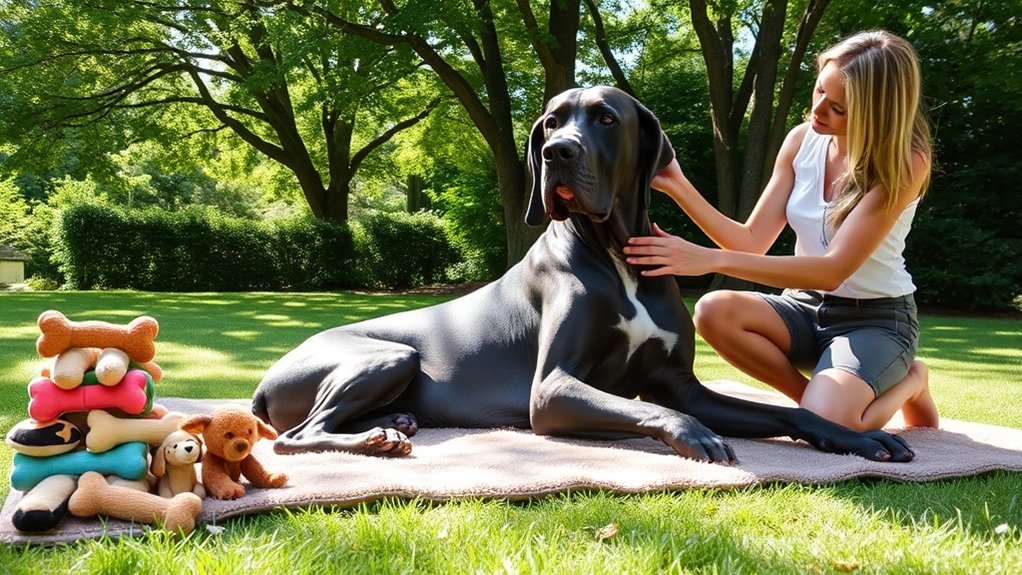
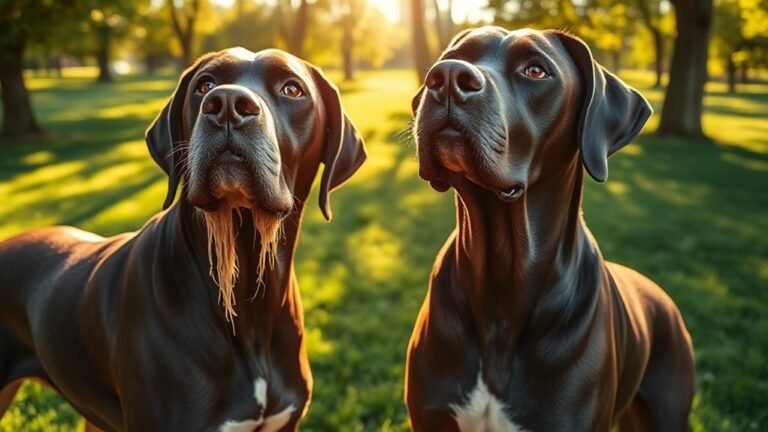

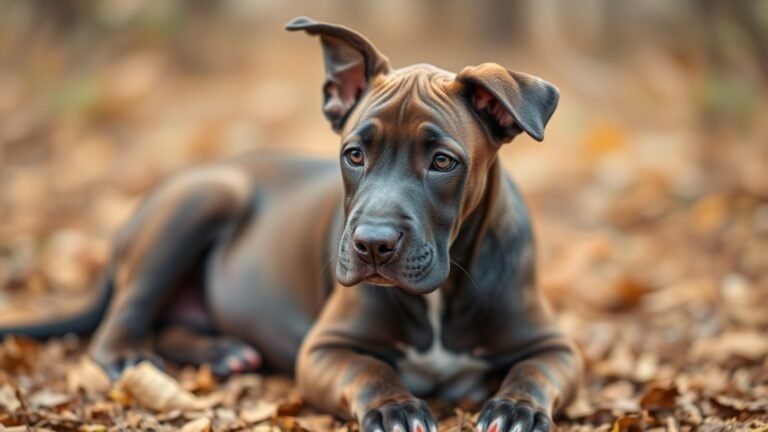
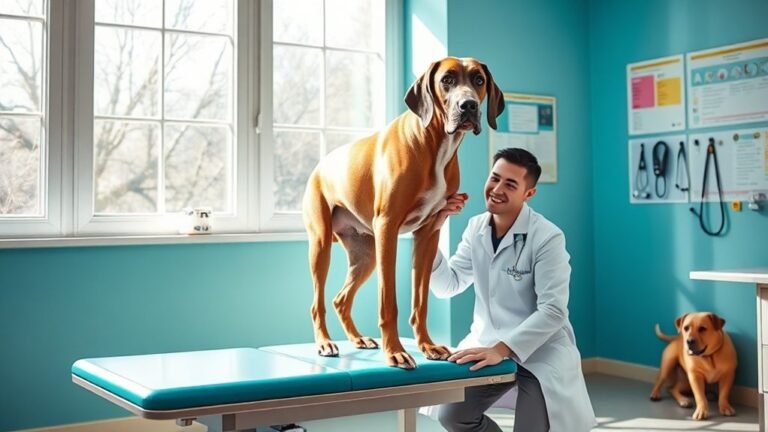
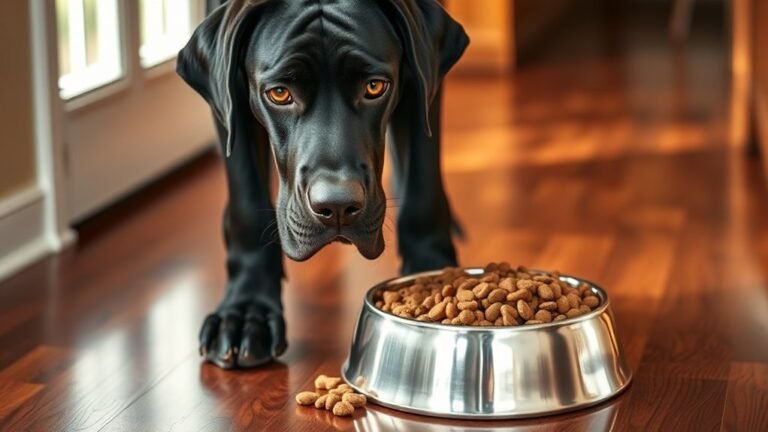
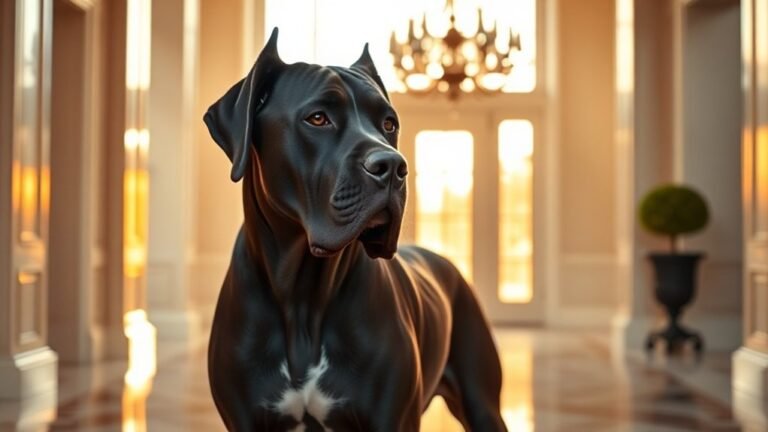
23 Comments